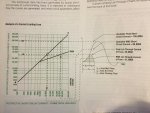Grouch
Senior Member
- Location
- New York, NY
Hi all,
I attached a graph below that explains current limiting fuses. this is from the 'Selecting Protective Devices' Manual by Cooper Bussmann. I have a bit of confusion where the x-axis on the graph says 'Symmetrical RMS amps'. If you look on the current waveform on the right, it shows the first half cycle right after a fault condition... but this is the Asymmetrical current... this is not symmetrical. The values from the waveform are placed onto the graph on the left... how come the x-axis wouldn't be labeled "PROSPECTIVE SHORT-CIRCUIT CURRENT - ASYMMETRICAL RMS AMPS"?
I attached a graph below that explains current limiting fuses. this is from the 'Selecting Protective Devices' Manual by Cooper Bussmann. I have a bit of confusion where the x-axis on the graph says 'Symmetrical RMS amps'. If you look on the current waveform on the right, it shows the first half cycle right after a fault condition... but this is the Asymmetrical current... this is not symmetrical. The values from the waveform are placed onto the graph on the left... how come the x-axis wouldn't be labeled "PROSPECTIVE SHORT-CIRCUIT CURRENT - ASYMMETRICAL RMS AMPS"?

